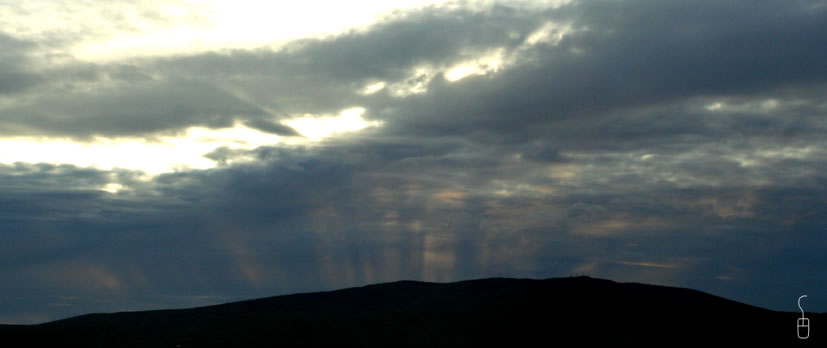
OPOD
What's New
Rays & Shadows
Crepuscular rays
Formation
Sky-wide rays
Lunar rays
Reflected rays
More images
Mystery Painting
Anti-crepuscular
Cloud shadows
Mountain Shadow
Earth's Shadow Blue Sky
Sunsets
Sunset Mirages
Green Flash
Moonrise/set
Opposition effect
Water Droplets
Rainbows
Ice Halos
High Atmosphere
Links & Resources
Search - Index
123456789012345678

| Reflected Crepuscular Rays |
 Rays
pointing in two directions! Mouse over the image - the lower orange
red rays point downwards to below the hill, the upper white rays point
in a different direction to somewhere in the sky above the hill. Poul
Jensen took this and other images on 1st September '06 looking towards
Ester Dome from the Geophysical Institute at the University of Alaska,
Fairbanks. The sun was 5° high and above the hill
but hidden by cloud. What then produced the seemingly impossible lower
rays? Image
©2006 Poul Jensen, shown with permission.
Rays
pointing in two directions! Mouse over the image - the lower orange
red rays point downwards to below the hill, the upper white rays point
in a different direction to somewhere in the sky above the hill. Poul
Jensen took this and other images on 1st September '06 looking towards
Ester Dome from the Geophysical Institute at the University of Alaska,
Fairbanks. The sun was 5° high and above the hill
but hidden by cloud. What then produced the seemingly impossible lower
rays? Image
©2006 Poul Jensen, shown with permission. Careful measurements of the
images show that the upper short white rays from a hole in the clouds
point towards the sun. The lower coloured rays have a focus below
the skyline and ~5° below the astronomical horizon. Poul Jensen provided
the explanation for their appearance. They are reflected
light crepuscular
rays. They are formed by upward going
rays from the reflection of the low sun off a group of lakes 50-70km
beyond the foreground hill and in the swampy Minto Flats Game Refuge.  Direct rays from the sun "a" penetrate a hole in the clouds to form the upper white rays in the image. Rays "b" reflected from the distant lakes appear to rise from a virtual sun below the horizon to form the lower orange rays. Not so improbable as it sounds because at that solar altitude, 70% or so of the incident light would be reflected upwards from a smooth lake. The reflected crepuscular rays will be partially polarised - something to look out for if you suspect that you see them. More reflected rays. |